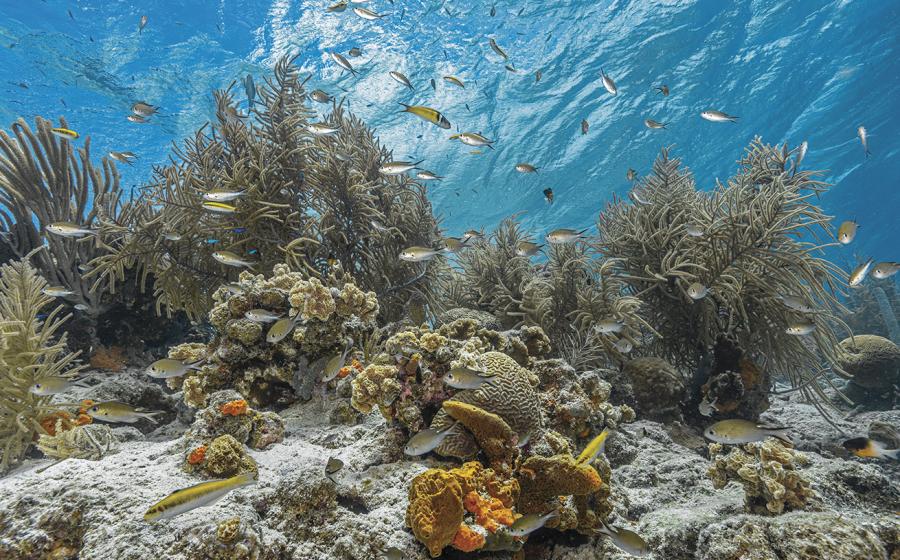Film vs. Digital
 |
| Advantage digital: Immediate image review allows you to make adjustments before your next shot. Photography by Stephen Frink |
Photography by Stephen Frink
After we featured the winners of the Bonaire Digital Shootout in the March issue, reader Sam Estes wrote to give us his thoughts on the art of digital photography. "It's apparent that the 'secrets' to award-winning photographs are a digital camera and a PC with Photoshop," he wrote. "These photographs are impressive, but I question whether they could be captured with the same consistency under the same circumstances while using film."
The digital-vs.-film debate has raged in recent years, with old-school film hounds questioning the technical skill required to create images that can be tweaked infinitely after capture, and digital fans wondering why anybody would want it any other way. Let's take a look at the issues most often raised in the debate:
Immediacy of Review
In many respects, digital imaging facilitates a rapid learning curve. Actually seeing an image on an LCD screen immediately after clicking the shutter is a huge advantage of digital over film.
While absolute confirmation of fine focus may be difficult on a screen less than two inches square, other important feedback for exposure, composition and the balance between foreground and background light is readily available. You can make corrections if necessary and swim away from a set-up knowing whether you nailed the shot or not. Compare that with normal film processing, where validation is hours or, more likely, days or weeks away.
Control
||
|---|
|  |
|
| With digital, I was able to change the ISO setting for this single frame to stop the action. Photography by Stephen Frink|
The digital camera is in many ways more flexible than the film camera. You can switch ISO equivalents per frame, rather than per roll as with film. This can be an asset in underwater imaging, where you can't change rolls on a single dive.
White balance is another area of control that the digital camera has over film. I leave my camera set on the "cloudy" day setting to warm the scene and offset some of the cyan bias common to underwater photos. I also capture my images in the RAW format to preserve all of the information possible. That way, if necessary, I can easily readjust white balance while viewing the images on my computer screen. The controls on the new Adobe Photoshop Camera RAW software mimic the white balance settings on the camera, and can replicate what would have happened if a different white balance setting had been chosen. Slider bars for both exposure and color temperature permit even more subtle adjustments. This kind of control goes far beyond the adjustment capacity of film, particularly slide film, where once it comes out of the developer, what you see is what you get.
Exposure is also more forgiving with digital than film. Like film, if you overexpose significantly, the shot is probably trash. Once the pixels are blown out, the information is gone and you can't bring it back. Same with film. But with digital, you probably will have seen the overexposure on the LCD screen and will have had a chance to reshoot with a different aperture or strobe power setting. With underexposure, digital allows significant redemption qualities via "levels" adjustment in Photoshop. To an extent, similar controls are available to a film shooter in the analog darkroom or with a scanned image, but it is certainly easier to effect "underexposure salvation" on digital than it is with film.
Resolution
This is a huge issue, and one where I think there's still some advantage to using film. With cameras now passing the 11-megapixel mark, there isn't much of a discernible difference between a 20x30 print from a digital capture or a 35mm slide. The arguments rage about whether the grain you see with film is better or worse than the pixels you see with an electronic image. Shooters on both sides of the issue make compelling arguments, but no one can argue that the clear advantage that film once had in the resolution department is eroding. Film would be better for prints 30x40 or larger; but for smaller sizes, it's probably a nonissue.
Organization
 |
| Many digital cameras make a 14mm lens perform like a 20mm, not nearly wide enough for some subjects. Photography by Stephen Frink |
While you can edit your images much faster with digital photos, you'll probably end up taking more. Maybe it's as easy to drag them into the recycle bin on your computer's desktop as it is to drop them in the trash bin next to your light table, but the sheer mass of resulting imagery can be overwhelming.
There is something formal and disciplined about critically evaluating a slide through a high-quality loupe. It creates a reverence for photography that may well be lost in the next generation of digital shooters. Plus, it's much easier to grab a 35mm slide from a vis sheet than it is to edit from a digital database, make Photoshop corrections, and then burn to a CD or upload to the internet for review.
Before there were digital options, a photographer's world was the viewfinder of his camera and the results of E-6 processing. While some of us may long for the simpler times before Nikon View and Photoshop entered the picture, there's no going back now.
Commercial Photography
For magazine reproduction, the magic number is 300 dpi. Whatever size the digital file can render at 300 dpi is the size it can be used on a page. Now that the high-end digital-SLR cameras are able to deliver full-page images, and even spreads, most editors will accept either film or digital.
In the stock photography business, digital images are only just now becoming accepted media, and there is no universal workflow or acceptance criteria. Preferred file sizes range from 30 to 100 megabytes, and digital guidelines vary from agency to agency. But as Alfonso Gutierrez of AGE FotoStock says, "From the stock photography perspective, there are no subjects that could not be photographed with a digital camera, and in almost all cases with a lot less hassle and a lot more possibility of getting what you want without waiting to come back home to see the results."
Of course, he has never tried to shoot a scuba diver silhouetted against the ball of sun with digital and lost the subtleties of the shades of white, turquoise and blue that film so artfully delivers. There are limitations for digital capture, particularly in terms of super-wide-angle images and high-contrast scenes. For wide-angle, I shoot film first, and if the subject permits, back it up with digital. But for fish and macro images, I prefer digital.
The Bottom Line
Your own vision and aesthetic will help you decide whether film or digital is your tool of choice, but be assured the line separating quality and convenience is blurring. The digital genie is out of the bottle, and it's not going back in.
|| |---|
| |
| Advantage digital: Immediate image review allows you to make adjustments before your next shot. Photography by Stephen Frink|
|
| Advantage digital: Immediate image review allows you to make adjustments before your next shot. Photography by Stephen Frink|
Photography by Stephen Frink
After we featured the winners of the Bonaire Digital Shootout in the March issue, reader Sam Estes wrote to give us his thoughts on the art of digital photography. "It's apparent that the 'secrets' to award-winning photographs are a digital camera and a PC with Photoshop," he wrote. "These photographs are impressive, but I question whether they could be captured with the same consistency under the same circumstances while using film."
The digital-vs.-film debate has raged in recent years, with old-school film hounds questioning the technical skill required to create images that can be tweaked infinitely after capture, and digital fans wondering why anybody would want it any other way. Let's take a look at the issues most often raised in the debate:
Immediacy of Review
In many respects, digital imaging facilitates a rapid learning curve. Actually seeing an image on an LCD screen immediately after clicking the shutter is a huge advantage of digital over film.
While absolute confirmation of fine focus may be difficult on a screen less than two inches square, other important feedback for exposure, composition and the balance between foreground and background light is readily available. You can make corrections if necessary and swim away from a set-up knowing whether you nailed the shot or not. Compare that with normal film processing, where validation is hours or, more likely, days or weeks away.
Control
|| |---|
| |
| With digital, I was able to change the ISO setting for this single frame to stop the action. Photography by Stephen Frink|
The digital camera is in many ways more flexible than the film camera. You can switch ISO equivalents per frame, rather than per roll as with film. This can be an asset in underwater imaging, where you can't change rolls on a single dive.
|
| With digital, I was able to change the ISO setting for this single frame to stop the action. Photography by Stephen Frink|
The digital camera is in many ways more flexible than the film camera. You can switch ISO equivalents per frame, rather than per roll as with film. This can be an asset in underwater imaging, where you can't change rolls on a single dive.
White balance is another area of control that the digital camera has over film. I leave my camera set on the "cloudy" day setting to warm the scene and offset some of the cyan bias common to underwater photos. I also capture my images in the RAW format to preserve all of the information possible. That way, if necessary, I can easily readjust white balance while viewing the images on my computer screen. The controls on the new Adobe Photoshop Camera RAW software mimic the white balance settings on the camera, and can replicate what would have happened if a different white balance setting had been chosen. Slider bars for both exposure and color temperature permit even more subtle adjustments. This kind of control goes far beyond the adjustment capacity of film, particularly slide film, where once it comes out of the developer, what you see is what you get.
Exposure is also more forgiving with digital than film. Like film, if you overexpose significantly, the shot is probably trash. Once the pixels are blown out, the information is gone and you can't bring it back. Same with film. But with digital, you probably will have seen the overexposure on the LCD screen and will have had a chance to reshoot with a different aperture or strobe power setting. With underexposure, digital allows significant redemption qualities via "levels" adjustment in Photoshop. To an extent, similar controls are available to a film shooter in the analog darkroom or with a scanned image, but it is certainly easier to effect "underexposure salvation" on digital than it is with film.
Resolution
This is a huge issue, and one where I think there's still some advantage to using film. With cameras now passing the 11-megapixel mark, there isn't much of a discernible difference between a 20x30 print from a digital capture or a 35mm slide. The arguments rage about whether the grain you see with film is better or worse than the pixels you see with an electronic image. Shooters on both sides of the issue make compelling arguments, but no one can argue that the clear advantage that film once had in the resolution department is eroding. Film would be better for prints 30x40 or larger; but for smaller sizes, it's probably a nonissue.
Organization
|| |---|
| |
| Many digital cameras make a 14mm lens perform like a 20mm, not nearly wide enough for some subjects. Photography by Stephen Frink|
|
| Many digital cameras make a 14mm lens perform like a 20mm, not nearly wide enough for some subjects. Photography by Stephen Frink|
While you can edit your images much faster with digital photos, you'll probably end up taking more. Maybe it's as easy to drag them into the recycle bin on your computer's desktop as it is to drop them in the trash bin next to your light table, but the sheer mass of resulting imagery can be overwhelming.
There is something formal and disciplined about critically evaluating a slide through a high-quality loupe. It creates a reverence for photography that may well be lost in the next generation of digital shooters. Plus, it's much easier to grab a 35mm slide from a vis sheet than it is to edit from a digital database, make Photoshop corrections, and then burn to a CD or upload to the internet for review.
Before there were digital options, a photographer's world was the viewfinder of his camera and the results of E-6 processing. While some of us may long for the simpler times before Nikon View and Photoshop entered the picture, there's no going back now.
Commercial Photography
For magazine reproduction, the magic number is 300 dpi. Whatever size the digital file can render at 300 dpi is the size it can be used on a page. Now that the high-end digital-SLR cameras are able to deliver full-page images, and even spreads, most editors will accept either film or digital.
In the stock photography business, digital images are only just now becoming accepted media, and there is no universal workflow or acceptance criteria. Preferred file sizes range from 30 to 100 megabytes, and digital guidelines vary from agency to agency. But as Alfonso Gutierrez of AGE FotoStock says, "From the stock photography perspective, there are no subjects that could not be photographed with a digital camera, and in almost all cases with a lot less hassle and a lot more possibility of getting what you want without waiting to come back home to see the results."
Of course, he has never tried to shoot a scuba diver silhouetted against the ball of sun with digital and lost the subtleties of the shades of white, turquoise and blue that film so artfully delivers. There are limitations for digital capture, particularly in terms of super-wide-angle images and high-contrast scenes. For wide-angle, I shoot film first, and if the subject permits, back it up with digital. But for fish and macro images, I prefer digital.
The Bottom Line
Your own vision and aesthetic will help you decide whether film or digital is your tool of choice, but be assured the line separating quality and convenience is blurring. The digital genie is out of the bottle, and it's not going back in.






